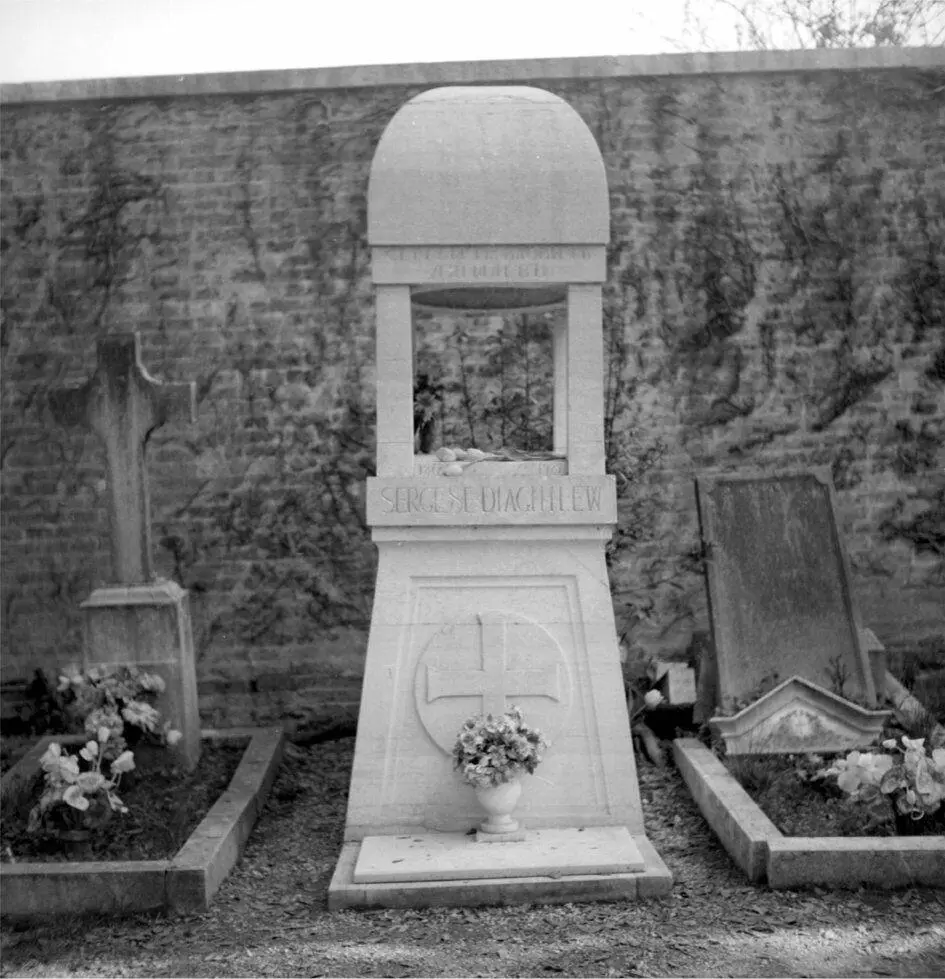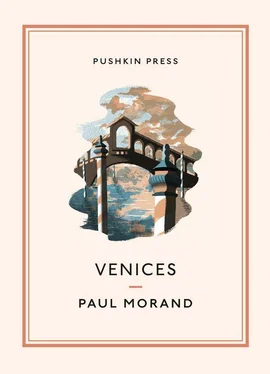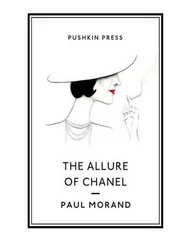Paul Morand - Venices
Здесь есть возможность читать онлайн «Paul Morand - Venices» весь текст электронной книги совершенно бесплатно (целиком полную версию без сокращений). В некоторых случаях можно слушать аудио, скачать через торрент в формате fb2 и присутствует краткое содержание. Год выпуска: 2013, Издательство: Pushkin Collection, Жанр: Современная проза, на английском языке. Описание произведения, (предисловие) а так же отзывы посетителей доступны на портале библиотеки ЛибКат.
- Название:Venices
- Автор:
- Издательство:Pushkin Collection
- Жанр:
- Год:2013
- ISBN:нет данных
- Рейтинг книги:5 / 5. Голосов: 1
-
Избранное:Добавить в избранное
- Отзывы:
-
Ваша оценка:
- 100
- 1
- 2
- 3
- 4
- 5
Venices: краткое содержание, описание и аннотация
Предлагаем к чтению аннотацию, описание, краткое содержание или предисловие (зависит от того, что написал сам автор книги «Venices»). Если вы не нашли необходимую информацию о книге — напишите в комментариях, мы постараемся отыскать её.
Venices — читать онлайн бесплатно полную книгу (весь текст) целиком
Ниже представлен текст книги, разбитый по страницам. Система сохранения места последней прочитанной страницы, позволяет с удобством читать онлайн бесплатно книгу «Venices», без необходимости каждый раз заново искать на чём Вы остановились. Поставьте закладку, и сможете в любой момент перейти на страницу, на которой закончили чтение.
Интервал:
Закладка:
On the 19th of August 1929, a few days before my arrival, the ceremonial floating bier that is used for funeral processions in Venice ferried the magician’s mortal remains to the funeral island of San Michele. Lifar threw himself into the grave. Whenever I see a funeral procession on its way to San Michele, with the priest in charge of the ceremony standing behind the gondolier at the stern, the funeral director at the prow, and with the silver Lion of St Mark concealing its affliction beneath its folded wings, I think of Diaghilev, that indefatigable man, lying at rest.

Serge Diaghilev’s tomb on the island of San Michele, Venice
Death would not quell the storm in which Diaghilev lived; his death throes had imposed a truce upon irreconcilable passions; it was broken the moment he breathed his last; at the foot of his bed, the two friends who had looked after him immediately hurled themselves upon one another. I was given an account of his final moments by the three women who were present, Misia, Chanel and the Baronne Émile d’Erlanger.
As Byron wrote to Murray, from Venice, on the 25th of November 1816: “Love, in this part of the world, is not a sinecure.”
1929
A FEW OF THE SURROUNDINGS had changed: on the Lido there were now a huge number of beach huts, those symbols of social prestige that are what the boxes at La Scala were in Stendhal’s time. The iron Accademia Bridge had been covered in a wooden construction, in the manner of Carpaccio or Bellini; the Palazzo Franchetti had acquired a lawn.
From having struck their bell so frequently, in my absence, the arms of the two Moors — the Mori —who chime the hour at the Mercerie, had grown very stiff.
THE ISLAND OF SAN LAZZARO
EVER SINCE the Lido began to rival Saint-Tropez, the contrast of this beach with the island of San Lazzaro, a stone’s throw away, has become ever more striking. After the hell of the summer, one finds the calm of prayer; one savours every moment spent beneath the magnolia, at the centre of the cloister, which seems to repeat itself like the beads of a rosary. La Serenissima gave this little island to the Armenian Mekhitarist monks when they arrived from Crete, where they had been driven out by the Turks, and they found a refuge here, far from the sunburnt, shaven legs and those infra-red cooked chickens. An Armenian patron has just provided the monastery with a large octagonal building, shaped like a church dome and built with air-conditioning, in which to keep their manuscripts; all that remains of a very great civilization; we never realised that a civilization would be able to be conserved in a room half the size of the reading room in the Bibliothèque Nationale! The Armenian rite, like the Orthodox, knew and recognised the value of mystery: a curtain conceals the celebrant (a velvet curtain, woven in gold, a gift from the late Queen Margherita of Italy); thrice, at the Consecration, and before and after Communion, the priest disappears from the congregation’s view; God is the winner.
I had not set foot in the Armenian monastery for fifty years; for such an ancient civilization, that was a mere flash. The cypress trees had grown taller and the sea breezes had turned them brown, while the Melchite Friars, their “beards the colour of meteors” ( Byron ), had grown white; their cemetery had doubled in size. This Eastern Catholic rite, divided as Venice is, and as I myself am, between East and West, between the Roman faith and Orthodoxy, was given refuge here after the defeat of Morosini in Morea, in the seventeenth century. Along with Vienna and Etchmiadzin, the home of these monks with their black habits remains a famous centre for Byzantine studies. Napoleon, who closed down the monasteries, respected these Venetian anchorites; was he preserving them for the fulfilment of his oriental dream?
I feel grateful to them for being the first importers of angora cats to the West.
PROUST AT THE ARMENIAN MONASTERY
THREE TIMES A WEEK, Byron rowed from Venice to San Lazzaro, where he came to learn Armenian; in the visitor’s book, we read, alongside his signature: “Byron, English”. (He despised England, but he was proud of her when he was abroad.) Proust, in his turn, would come to add his name to the register in the spring of 1900; not being a nostalgic exile, he did not put “French” after his name.
It is hard to believe that in late 1919 Proust still had difficulties in placing an article about Venice in the newspapers, hoping humbly that “it would be accepted”. Throughout his life, Proust promised himself trips to Venice; when the Great War was over, he used to say, he hoped to be able to return there with Vaudoyer or with me, once his book was completed; he had dreamt about the city for a long time, ever since childhood, just like his grandmother who, in her case, never went there; he thought about it when he spent the autumn at Evian, in early September, when the Lake of Geneva takes on a Lombardian softness and seems to grow more like the Borromée islands, from which it is barely separated by the once impassable mass of the Simplon, now easily crossed or tunnelled through; the same summer palaces, the same clarity of its shores, the same truite au bleu colour of its morning surfaces.
Proust had a special feeling for Venice (and not just for those neckties from Au Carnaval de Venise , on the Boulevard des Capucines, which Charles Haas bought). How could he escape from the World Exhibition,16 he wondered, how could he travel to the magical city on his own, when he was so ill? He needed a companion, but he couldn’t find one; one of his letters, dated October 1899, is nothing but a cry from the heart for Venice. Why didn’t Emmanuel or Antoine Bibesco — the two nephews of the famous composer, at whose home, the Villa Bessaraba at Amphion, Proust so often stayed — why didn’t one of them go along as his guide? Italy was only three hours away… In early May 1900, Proust learnt that Reynaldo Hahn and his cousin Marie Nordlingen were in Rome and would be going on to Venice. He couldn’t stand it any longer and persuaded Mme Proust to accompany him; in the train, after they had passed Milan, she translated Ruskin for him…
In the index to the Pléiade edition of À la recherche, there are a hundred listings for Venice; we see Proust so intoxicated by this city which he had finally conquered that he had forgotten his dreaded fevers: a young man exhilarated by the splendour of St Mark’s; a Marcel who astonished his mother because he found the strength to be up at ten o’clock in the morning, etc.17
The month of May came and went; the Proustian acid combined marvellously well with the Venetian base. La Fugitive contains a hundred divers impressions in which Venice merges or fuses with Combray (the function of the houses in the Grand-Rue compared to that of the palaces, the relationship between the sunlight playing upon the awnings on the canal and those on the family drapery shop, the comparison of the Danieli Hotel and Aunt Léonie’s home, etc.). The Conversation avec Maman in Contre Sainte-Beuve reveals further recollections: “At lunchtime, when my gondola brought me back, I noticed Mamma’s shawl upon the alabaster balustrade”, etc.
These memories from Contre Sainte-Beuve precede those in La Fugitive ; what they have in common is that they both mention a tiff between mother and son that has always intrigued me, a curious quarrel which, considering that this disagreement was to have such lasting overtones, one would like to be able to shed some light upon; the odd thing about them is that Contre Sainte-Beuve , which was published first (although it is difficult to establish a firm date, since it is made up of fragments collected together between 1905 and 1909), tells us about “an evening when, spitefully, after a quarrel with Mamma, I told her that I was leaving (Venice)… I had given up my idea of leaving, but I wanted to spin out Mamma’s sadness at believing that I had left”. It is the son, therefore, who in this instance wants to return to Paris (but since his mother has only come to Venice for his sake, one fails to understand why she did not yield to her son’s wish to return)… whereas, later, in La Fugitive , in which the visit to Venice is treated at greater length, the situation is reversed; this time, it is the Narrator who refuses to leave Venice and return to Paris with his mother: “My mother had decided that we should leave… my plea (to remain) aroused in my nerves, stimulated by the Venetian springtime, that old desire to resist… that determination to fight which once used to drive me to impose my own will brutally upon those I loved most.” We know what ensued: having allowed his mother to leave for the station, the Narrator rushes after her and catches up with her just before the train is about to depart; it’s a long way from the Danieli to the Stazione, but the surge of filial affection shortens the journey. The umbilical cord remains uncut once more.
Читать дальшеИнтервал:
Закладка:
Похожие книги на «Venices»
Представляем Вашему вниманию похожие книги на «Venices» списком для выбора. Мы отобрали схожую по названию и смыслу литературу в надежде предоставить читателям больше вариантов отыскать новые, интересные, ещё непрочитанные произведения.
Обсуждение, отзывы о книге «Venices» и просто собственные мнения читателей. Оставьте ваши комментарии, напишите, что Вы думаете о произведении, его смысле или главных героях. Укажите что конкретно понравилось, а что нет, и почему Вы так считаете.












